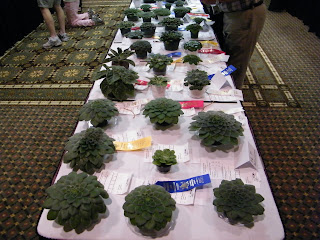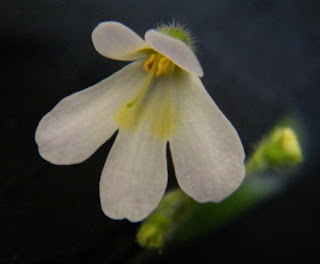If you've never been to a plant show or plant society convention, and you love plants, you simply must make a point to attend just one in your lifetime. For plant lovers, the chance to see choice and rare specimens grown to near perfection, is a truly memorable event. The highlight of my year is each July when the annual convention of the Gesneriad Society rolls around. It is traditionally held during the week of July 4th. This year, the convention was held in Silver Spring, Maryland from June 29-July 5th. Gesneriad lovers from all over the world descended upon the hotel to hold another week of good times among good friends and to showcase our beloved gesneriads. The convention includes a judged show, several lectures, a plant sale, and other social events such as banquets, luncheons, classes, workshops and tours of local botanical venues.
As I said, I look forward to this event for a whole year. I've been attending them whenever I could for the past nine years and always have a wonderful time. For me, it is a chance to reconnect with friends who I may not have seen since the last convention. This year was a special year for my favorite genus, Petrocosmea. The show included an unusually high number of entries for this genus. There are a number of classes in the show, in which Petrocosmea could be entered. Since most Petrocosmea are winter bloomers, a summer show usually means that most Petrocosmea entered will be entered in the horticultural class for "Petrocosmea- not in flower". This year, that class was very large. So large, in fact, that the class was split into several smaller classes in order to give each plant entered more of a chance to win an award if it scored well. This made the class a tough one for judges to judge.
Judging Petrocosmea not in flower places a LOT of emphasis on the plant's "ornamental value". Petrocosmea, not in flower, can be quite uninteresting to many judges. Others, however, assign a good degree of merit for ornamental value to Pets that are tight, symmetrical, unblemished, flat rosettes. A debate often ensues about the amount of skill required to grow a Petrocosmea in such a manner, since the genus has a natural tendency to produce growth that is flat, symmetrical, an a tight, round rosette. That being the case, some judges say very few points should be assigned to such plants, since the grower had little skill invested to accomplish such a result. Obviously, I see a Petrocosmea, not in flower, as a very beautiful thing. I love them in or out of flower and I think they are among the most ornamental of gesneriads. But, being a Master Judge, I am obliged to give merit to the counterpoint that says this is plain and uniteresting and does not show a lot of ornamental value. As a judge, I tend to demand a little more from a Petrocosmea entered into a show if I'm going to give it high points for ornamental value.
Nonetheless, this years show being only four hours drive away from Pittsburgh, allowed me the rare opportunity to drive to convention and therefore, take entries for the show. I took 15 entries this year. Four of those were Petrocosmea. When scoring was completed, I was thrilled to see that all of my Petrocosmea had scored above 90 points, and my entry of Petrocosmea rosettifolia #3 had won a first place ribbon in it's class, and Best Petrocosmea!!! I was proud of all of my ribbons, but winning Best Petrocosmea in a convention show with so many Petrocosmea entries was the highlight of my year
!!  My entry of Petrocosmea rosettifolia #3, which won first place in it's class and Best Petrocosmea for the show!!!
My entry of Petrocosmea rosettifolia #3, which won first place in it's class and Best Petrocosmea for the show!!!
Petrocosmea almost always feature prominently in the Collection classes. This year, there was a beautiful presentation of five Petrocosmea grown by Paul Kroll, of East Aurora, NY. Paul is an expert grower of all gesneriads, and he never fails to deliver some stunning examples of Petrocosmea grown to perfection. The choice of a brown, earth tone, cloth to unify the collection was most attractive. The earthtones complimented the colors of the foliage, in my opinion, and were a welcome change from the more common use of black cloth for such a purpose. I particularly liked the silvery foliage on the plant of P. 'Shortnin' Bread' in the front against the brown cloth. This collection, starting with the plant in the back and moving clockwise includes, P. parryorum, P. sericea, P. 'Shortnin' Bread', P. sp. 'Yumebutai' and P. sp. 'HT-2'.
 A very well grown and floriferous Petrocosmea begoniifolia , which won first place in the Petrocosmea in flower class. This is not my plant, but I wish it was!!
A very well grown and floriferous Petrocosmea begoniifolia , which won first place in the Petrocosmea in flower class. This is not my plant, but I wish it was!!
The class for Petrocosmea -Not in Flower was so large that it was split. There were enough entries of the new Pet hybrid 'Shortnin' Bread' that it has a class all by itself!!
 A PARTIAL view of the table holding all of the Petrocosmea Not in Flower entries at this year's convention show. It was the largest class for Petrocosmea ever!!!
A PARTIAL view of the table holding all of the Petrocosmea Not in Flower entries at this year's convention show. It was the largest class for Petrocosmea ever!!!
Did such a large increase in the number of entries for Petrocosmea represent the degree of interest in this popular genus of gesneriads? I hope so. I was certainly thrilled to see so many examples of Petrocosmea in one show. The large number of those entries which were in the "not in bloom" sections, however, I think tells those of us who are working with hybridizing within this genus that the need to produce new hybrids that are floriferous, that bloom in the summer or year round, and the have more interesting foliage characteristics must be a major focus. Judges are going to very soon start to demand much more from these plants with regard to flowering and ornamental value. Hhhmmm, "note to self".........
If you did not make it to this years convention show, plan to attend in the future. If you cannot make it to a convention show, seek out the nearest local chapter shows of gesneriad and African violet clubs, and seek out the Petrocosmeas!!!
Tim
 xAchimenantha 'Dutch Treat' makes a beautiful display with masses of dime-sized little red flowers with glowing yellow throats over dark red-haired foliage.
xAchimenantha 'Dutch Treat' makes a beautiful display with masses of dime-sized little red flowers with glowing yellow throats over dark red-haired foliage.  The lovely pink bells of xSmithicodonia 'Behavin' ' are a delicate crown of beauty atop the crown of bronzy purple leaves.
The lovely pink bells of xSmithicodonia 'Behavin' ' are a delicate crown of beauty atop the crown of bronzy purple leaves.  The lovely pink bells of xSmithicodonia 'Behavin' ' are a delicate crown of beauty atop the crown of bronzy purple leaves.
The lovely pink bells of xSmithicodonia 'Behavin' ' are a delicate crown of beauty atop the crown of bronzy purple leaves. 
























